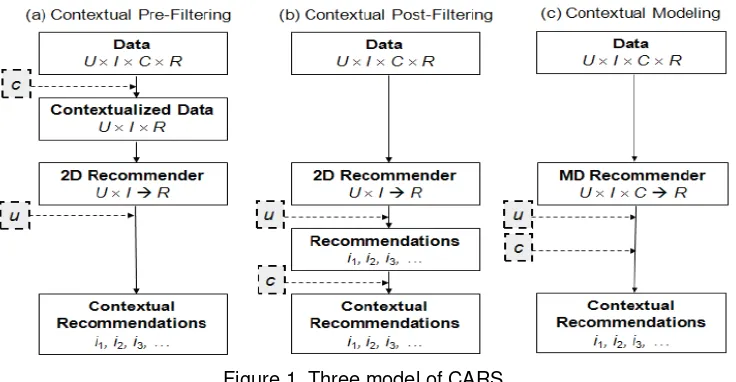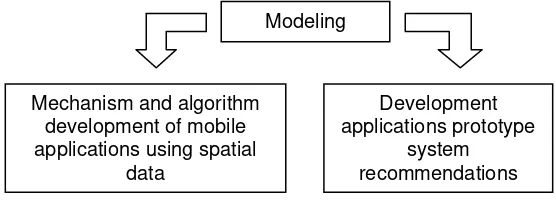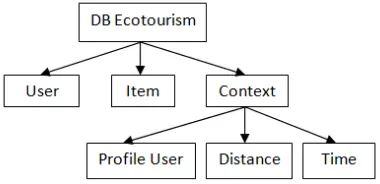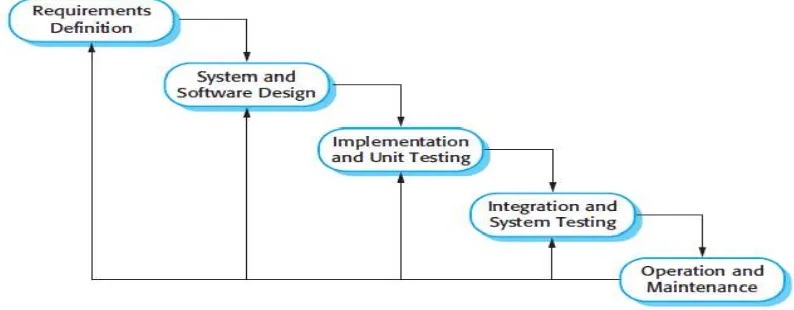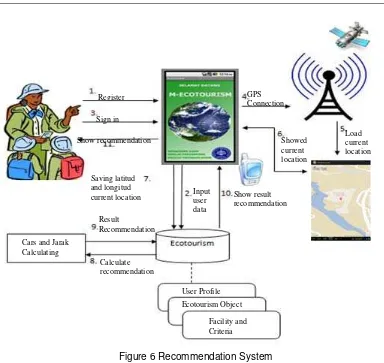DOI: 10.12928/TELKOMNIKA.v11i4.1680 845
A Mobile Ecotourism Recommendations System Using
Cars-Context Aware Approaches
Neny Rosmawarni, Taufik Djatna*, Yani Nurhadryani
Computer Science, Mathematics and Natural Sciences, Bogor Agricultural University Dramaga IPB, Bogor, 16680
Tel: (0251) 86228448, Fax: (0251) 8622986
*Corresponding author, e-mail: nenyrosmawarni@apps.ipb.ac.id, taufikdjatna@ipb.ac.id, ynurhadryani@yahoo.com
Abstrak
Saat ini kebutuhan untuk memenenuhi mobilitas kegiatan ekowisata dengan aplikasi perangkat mobile telah sangat mendesak, untuk mendukung pemberian informasi berupa rekomendasi kepada setiap wisatawan. Tujuan dari penelitian ini adalah untuk mengembangkan aplikasi sistem rekomendasi berdasarkan personalisasi pengguna secara online. Aplikasi ini menyedia fitur-fitur untuk rekomendasi obyek ekowisata berdasarkan profil pengguna dan lokasi saat ini, dapat memberikan informasi tentang jarak dan fasilitas disetiap tempat ekowisata. Inti dari perhitungan sistem rekomendasi yang digunakan pada penelitian ini berbasis pada pendekatan CARS algoritme (Context Aware Recommender Systems).Hasil penelitian menunjukkan bahwa rancangan aplikasi ini berhasil memberikan rekomendasi dan penjelasan yang sesuai profil dan preferensi pengguna dengan menggunakan data spasial yang diterapkan pada perangkat mobile.
Kata kunci: CARS,data spasial, ekowisata, profil pengguna, sistem rekomendasi
Abstract
The requirements to fullfill mobility of ecotourism activities have been urgent to support each traveler with the mobile gadget application. The objective of this research is to develop an application of recommendation system based on online user personalization. This application provided features to recommendation of ecotourism based on profile user and current location, then supplied information about distance and facilities in each ecotourism place. The main of computation worked online which was based on approach called as CARS (Context Aware Recommender Systems) algorithm. The result showed that the application framework succeeded to give appropriate recommendations and explaination on a mobile platform both in the form of profile based spatial data and user preferences.
Keywords: CARS, spatial data, ecotourism, profile user, recommendation system.
1. Introduction
Recommendation Systems (RSs) is one of the techniques of CRM strategy (Customer Relationship Management), in the form of software tools and techniques that can provide recommendations to users [1]. The system is an application of the model results and observations on the state of the user preferences. RSs can provide advice to the user through the process of decision by providing explanations and recommendations that help users find what they need or preferably made in the form of a system. Therefore, in making this system required methods appropriate recommendations in order to recommends in accordance with the individual profile of the user, as well as helping to facilitate users make the right decision [2]. This system includes the analysis of data from the user and extracting useful information for further predictions [3].
current research has been done in the field of recommendation systems, most existing approaches focus on recommending the most relevant items to users without taking into account additional Contextual information, such as time, location, or company of others (for example, to watch a movie or eat outside). CARS discuss general ideas and can be modeled in the context of recommendation systems. Three different algorithms paradigms: Contextual pre-filtering, post-filtering Contextual and Contextual modeling. CARS Contextual information as a basic priority of the technique used, the notion of context itself has many variations but the CARS has established that Context is meant here is the appropriate value and is unchangeable. It can be described as Figure 1.
Figure 1. Three model of CARS
In this research paradigm used is pre-filtering, Specification where U=User, I=Items, C=Context and R=Rating. Mobile application development RSs is developed for the case in ecotourism and the research paradigm used is pre-filtering in CARS. Ecotourism is one of the tourism sectors that can help the economy growing at this time. Ecotourism also a form of tourism that focuses on rural culture as a tourist attraction and a social activity [4]. Various attractions within spatial and dynamic offered to tourists in the tourist, tourists in this case is that users utilize all existing attraction at ecotourism. Tourism is also contributing to the increase in population and income can also promote local development.
The development of an understanding of ecotourism began in the 1970s with the development of nature-based tourism, which in essence is an "itinerary" which includes visits to places that are in the natural environment. In the early 1990s, the development and growth of ecotourism, along with nature tourism, cultural, historical heritage and adventure, has become the global tourism industry is experiencing the fastest growth rate.
The existing problem today are many attractions and locations spread with distance is not always close, and tourist facilities has particularly different. Location and tourist profiles are always dinamus and change-fox. The absence of ecotourism RSS applications that can provide recommendations based on prefrences of user profiles. Current RSS applications are generally made in the form of a web which tends to be static and passive, in this study the application of RSS was created in the mobile applications that support the tourists in helping recommending attractions that fit their profile.
This study focus on developing a mobile application for location recommendation system that supports ecotourism mobile applications using spatial data based on user profile. While the scope of this research are: 1) the application is used by a single user on each mobile device, 2) the application is made within the scope of Android mobile devices, 3) the data objects used in the research ecotourism specifically to the area of Bogor.
2. Research Method
Based on the purpose of the research, then the research methods section describes the process of achieving that goal. The steps, researchers conducted a study of literature, and then analyze the existing problems adapted to the literature review and carry out the data collection. Once the data has been collected, next step is modeling. In the preparation phase of this model, the researchers divided the process into 2 steps done in parallel. The first process, the development of mechanisms and algorithms of mobile applications using spatial data. The second process is to build a prototype application of recommendation systems. Once the second process is completed, then the next process is the implementation stage. At this step the two previous steps are combined, after the merger of the first step to the second step. If there is an error when evaluation then do the error checking. If the error is a logic error, the examination conducted at the first step and if the error occured in the form of bugs in the application, then examination conducted at the second stage. If there are errors in both the program has been completed and can be used. An overview of the modeling phase of this research method shown in Figure 2.
Figure 2. Modeling Procedures
2.1 Mechanism and algorithm design RSS
At the design stage, first of all researchers conducted the data collection process by conducting observation, questionnaires and interviews to traveler or tourists domestic and manager or owner of a ecotourist objects. In addition to filling out the questionnaire through the data retrieved using the tools of GPS (Global Positioning System). Data was taken from a survey of data users and data from ecotourism objects which will be stored into the database. Data points are taken, there are 14 existing objects in Bogor area. The data obtained will be formed into some context, namely, user profiles, distance, time. Data the data will be used in the calculation algorithm using RSS CARS method. The calculation is as follows:
Preparation of Model:
Preparation of this model is divided into 2 ways by developing mechanisms and algorithms of a system that is designed and built in a prototype application recommendation system. The methods used are as follows:
CARS Calculation Method
Phase calculation method recommendations CARS (Context Aware Recommender Systems). The stages of the CARS method used in this study are contextual pre-filtering.
Figure 3 is one of the models of the 3 approaches that can be used in the CARS method. There are 3 steps done in this approach to get contextualized data. The first phase is the data, the data here is the result of the analysis of the problem, and then carried out the data
Modeling
Development applications prototype
system recommendations Mechanism and algorithm
development of mobile applications using spatial
collection. The necessary data is user data that is symbolized by (u). User data obtained from user registration on ecotourism RSS application stored in the database. Meanwhile,the data item denoted by (i). Data items in the form of data in this study were obtained from the object ecotourism survey results and literature that discusses the special ecotourism to the region Bogor. While the data context symbolized (c). This data context obtained through the context generalization. Generalization context can be defined as follows:
' ' '
1 1
( ,...,
k)
( ,...,
k)
c
c
c
c
c
(1)Data needed next is symbolized by the rating, generalization pre-filtering also uses time context symbolized by the formula of rating so the search can be formulated which is a superset of the context-time. In this study, the results have a structure of context generalization hierarchy as Figure 4.
Figure 3. Flow model of contextual pre-filtering [6]
Figure 4 the structure of the hierarchy of contextual information
Hierarchical structure of the contextual information from the system created a database derived from ecotourism. From the Figure above shows a context in which this system is user profiles, distance and time. Figure 4 describes the relationship between the user context and items. It is very necessary known as the basis of making a recommendation system. The hierarchical structure calculations recommendation can be made by collecting existing data and then look for the rating of each user transaction with the item. Then be viewed from any context inherent in the transaction resulting in a rating on every transaction. The rating is the given rank is calculated by the above method results and appropriate recommendations. In this study, how to get context time is calculated based on the amount of time a user visits the site object ecotourism. As for how to get the user context profiles computed from the data filled in the registration form on the application and then stored into the database. Value taken for the user profile of the user registration form is age and hobby users. The calculated value of the two items and users, it is made prior to the data dictionary views ecotourism suitability of any object with the hobby of the user as one user preferences in the database as follows:
1. Register Hobby: fishing, swimming, reading, hiking, biking, camping, photography, explorers, traveling, culinary.
2. Data Object Ecotourism: the amenities provided and criteria of the rides on the attractions. Facilities on attractions that are provided by hobby user adjustable.
, ∑ (2)
Where d(p,q) is the current position of the user location, which is obtained from the GPS (Global Positioning System) and connected to the ecotourism application and appears on the map in the mobile. While ecotourism is the position of the object. Intended position is x and y of longitud and latitudes. Where x and y obtained from each user and object ecotourism. To calculate the similarity between user data with the data points those are already managed by context using the formula:
(3)
Where T is new transaction conducted user, S is a transaction that has been stored in memory (Database). Transaction here is the relationship between users with sights, n is the number of attributes on each transaction, i is the individual attributes of users between 1 to n. While f is a function of the similarity attribute i with transaction T and S. While w is the weight (rating) given to attribute to i. Calculations used in accordance with the time context (time) is to the similarity between the user and the object in terms of time travel is based on visits to these attractions. The formula for calculating proximity based on context-time (time) is similar to the calculation formula of the user context profiles. To compute the similarity with the context of time can be done with the formula:
(4)
Where X is a new transaction context of the user who made time, S is the time the transaction is stored in memory (Database). Transaction here is the relationship between users with sights, n is the number of attributes on each transaction, i is the individual attributes of users between 1 to n. While f is a function of the similarity attribute i with transaction T and S. While w is the weight (rating) given to attribute to i. Once the rating data obtained, the data is recommended by 2D. To get the necessary recommendation contextulization ranking of each rating item. The subsequent calculation formula used in this study to calculate the ranking in the context aware recommender systems is to use the formula below:
(5)
Where (p) is the probability of an item symbolized by (
d
) and the user is symbolized by( )
u
, while the context symbolized by a (value). So after doing the ranking of the weight of any transaction between users and attractions are selected based on context so that the recommended. Results have been 3 biggest recommendations from the results of calculations performed ranking.2.2 Prototype RSs Application Development
At this stage, application development is done using the waterfall approach to application development. As for the stages as Figure 5.
At this stage of the project idea, the design of the application is done by designing the system requirement specs. At this stage of the analysis done with the data design using UML (Unified Modeling Language), ERD (Entity Relational Diagram), and class diagrams. Then the results of the design, application design phase carried out in accordance with the results of phase analysis using the Java programming language in Android. The last stage is to perform testing and implementation.
System prototype application built is using the Android programming language. The method used in the manufacture of the prototype system using a system development method waterfall approach (Sommerville 2011). Hardware environment used is a laptop with minimum specs Intel Core i3 Processor, 2GB RAM, 650 GB HDD, 13-inch Lenovo monitor, Logitech Mouse, Tablet Samsung7.2 As a means of testing the system. Software environment used is
Operating System Microsoft Windows 7 (32 bytes), Android ADT as to produce software applications, MySQL as the database.
Figure 5. Method waterfall approach (Sommerville 2011)
3. Results and Analysis
Survey results, the points data are taken from 14 different objects in Bogor. Data used in addition to the points data, the data taken at the time of the survey is the user data, which is data obtained from questionnaires filled out by the user. Existing data on the questionnaire only used in decision-making concept of user profile data to a database that will be directly used this concept in the registration application form is filled in when the user first access the application. Forms of spatial data are captured in the form of longitude and latitude positions of each user and a tourist attraction. From the survey results, it was formed a tendencies (preference) from the user to the tourist attraction. The preference form will be created context information structure which will be used in the context of the recommendations to the user.
Researchers determined the design of the hierarchical structure of context information from the available data. To be able to generate the hierarchy of data which was done in advance of data filtering stage. After that, the data is processed and designed using the Class Diagram and ERD, in order to create a design and hierarchical structure. Once the structure of the hierarchy is made, then performed the calculation formula using CARS system recommendations tailored to the user's data. Once the calculation is complete, then proceed with the drafting of the application using the Android programming language and the results are incorporated into the formulation of the application. The result of the design of the recommendation system application framework mechanism is as Figure 6.
The Figure 6 explains in detail how workflow systems use the recommendations made, ranging from user can register, and if registration is done successfully then the input data will be stored in the database registers. If the data is stored into the database the user can sign in and do a GPS connection, after the GPS is connected then the application will load the data and displays the position we present information about the current position of the user is located. Then the system will perform data storage longitude and latitude of the current user position and sent to the database for further calculations on the method of context aware recommender systems. The calculation is done by looking on the LBS user position and attractions, then compared with the distance, and then viewed with a selected context. Furthermore, from the results of the recommendations will appear in the form of tourist attraction suggestions shown by using the pushpin in the map. But before using it, the application must obtain user data, the data is taken from the first registration when the user accesses the application.
Figure 6 Recommendation System
Figure 7. Mobile Application Coverage Ecotourism. Register
Sign in
Input user data
GPS Connection
Load current location Showed
current location
Facility and Criteria Ecotourism Object User Profile Saving latitud
and longitud current location
Cars and Jarak Calculating
Calculate recommendation Result
Recommendation
RSs is an advantage in the application is the application created using the CARS method based on user profile, ecotourism locations used in this study to the region Bogor, The deficiency of this application is making this application is still in prototype form, using only one SNS (Social Network Services), and assumed one gadget for one user.
4. Conclusion
Based on the results it can be concluded first goal of this research is ecotourism recommendation mechanisms have been developed with the method of the Context Aware Recommender Systems (CARS) to produce a recommendation that supports mobile applications using spatial data RSS ecotourism and the second goal can be summed up by the research results have made the recommendation system application on mobile devices developed based on user profiles with context approach, applied on a mobile device that can provide recommendations to users based on user profile by looking at the trend of liking for current user activity and location. So that the user can get information more efficiently because it can be accessed anywhere and anytime. This application can help facilitate users locate and find information about ecotourism attractions especially for Bogor area. It is suggested to do further research about: to evaluate the appropriateness rating prefrences user profile (a confirmation and refinement; and registration can be integrated with the user's profile through social networking, kedetailan data for additional features, and territorial expansion.
References
[1]. Ricci F, Rokach L, Shapira B, Kantor P B. Recommender Systems Handbook. New York (US): Springer. 2011.
[2]. McGinty L, Smiyth B. Adaptive selection: analysis of critiquing and preference based feed back in conversational recommender systems. International Journal of Electronic Comerce. 2006; II(2): 35-57.
[3]. Chen A Y, Mcleod D. Collaborative Filtering for information Recommendation System. Encylopedia of E-commerce, E-government, and Mobile Commerce. 2006: 118-183.
[4]. Sharda N. Tourism informatics: visual travel recommender systems social communities and Pengguna interface design. Information Science Reference. New York (US): Hershey. 2010
[5]. Julien C, Hammer J, O’Brien W.J. A Dynamic Programming Framework for Pervasive Computing Environments. In Proc.Of the workshop on Building Software for Pervasive Computing in conjuction with OOPSLA’ 05, San Diego, CA. 2005.
[6]. Adomavicius G dan Tuzhilin A. Context Aware Recommender Systems, Handbook Recommendation Systems. Berlin (DE): springer. 2011.
[7]. Avenzora R. Ekotourisme- teori dan praktek. Nias (ID): BRR NAD. 2008.
[8]. BPS. 2011. Statistik Telekomunikas Tahun 2011. http://www.bps.go.id/ hasil_publikasi/ stat_telkom_2011/index3.php?pub=Statistik%20Telekomunikasi%20Tahun%202011. [9]. Burke, R. Hybrid Web Recommendation System. In: the Adaptive Web, pp.377-408. Berlin/
Heidelberg (DE): springer. 2007.
[10]. Danardatu A H, Pengenalan Customer Relationship. Yogyakarta (ID): Andi. 2007.
[11]. Kahng M, Lee S, Lee S. Ranking In Context Aware Recommender Systems. ACM 978-1-4503-0637-9/11/03. 2001.
[12]. Rajabidfard A. Spatial Data Infrastructures: Concept, SDI Hierarchy and Future Directions.
Melbourne, Victoria: Spatial Data Research Group, Department of Geomatics, The University of Melbourne, 2000a. Spatial Data Infrastructures: An Initiative To Facilitate Spatial Data Sharing.
Melbourne, Victoria: Spatial Data Research Group, Department of Geomatics, The University of Melbourne (AU), 2000b.
[13]. Husain W dan Yih L. Dih. A framework of a personalized location based traveler recommendation system in mobile Application. International Journal of Multimedia and Ubiquitous Engineering. 2012; 7(3): 11-18.
[14]. Satzinger, John W, Robert BJ, Stephen D. Fourth Edition-System Analysis and Design in A Changing World. Canada (US): THOMSON. 2007
[15]. Singh S, Mobasher B. Contextual Recommendation.Springer-Verlag Berlin (DE) Heidelberg. B. Berendt et al. (Eds.): WebMine 2006, LNAI 4737, pp. 142–160, 2007.
[16]. Sommerville I. Software engineering - ninth edition. Boston (US): Addison Wasley-Pearson. 2011. [17]. Sunarminto T. Pengembangan kapasitas para pihak (Stakeholders) bagi pembangunan ekowisata di
